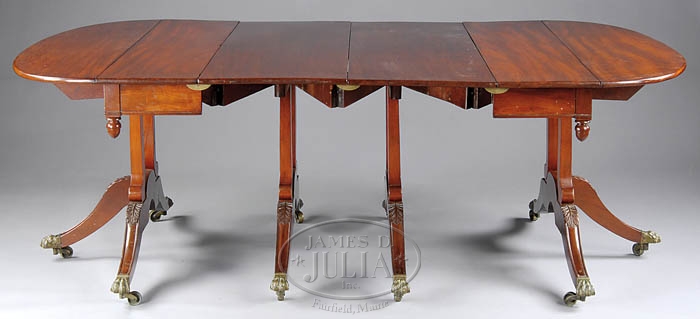| Image | Lot | Price | Description |
|
2044
|
$10,350.00
|
EXTREMELY RARE CLASSICAL MAHOGANY ACCORDION-ACTION EXTENSION DINING TABLE. Circa 1800-1820, New York, or Philadelphia. The rectangular plum pudding figured top with hinged demilune leaves above the conforming frieze, the apron with pendant acorn finials at the corners, raised on four lyre-base standards, the end standards each with three outswept legs brass-bound at the knees, the two center standards each with two outswept legs, all with acanthus-carved knees and molded legs, terminating in clawfoot casters. This example is offered with two additional and original 17-inch leaves. There is a third custom-made leaf (11 inches wide) that accompanies this table. Legs are attached to the oak accordion extension mechanism, first invented by Robert Gillow in 1800 in London, England. It is noted that the outer standards of three legs are known to have been mounted in either direction, i.e., the single leg at right angles to the others may extend either from the end of the table or, if desired, may be turned and mounted in such a way that it faces inward beneath the arch of the interior standards. One example sold at Christie’s in New York, January 16, 2003. Sotheby’s of New York offered the Martin Van Buren dining table on January 18, 2003. An additional example sold by Sotheby’s of New York October 7, 2006. Most of the known examples are similar but with slight variations on the baluster turnings and carving of the sabre legs. LITERATURE: 1) “Between 1760 and 1770 they [the Gillows] invented the original form of the billiard-table; they were the patentees (about 1800) of the telescopic dining-table which has long been universal in English houses” Excerpt from http://www.1911encyclopedia.org/Robert_Gillow)Based on the 11th Edition of the Encyclopedia Britannica – pub. 1911.) 2) Most tables of this form are now believed to be the work of New York cabinetmakers, though Nutting ascribed the example he published in the Furniture Treasury (fig. 1000) to Philadelphia, as one was sold by Israel Sack, Inc. (Encyclopedia of Furniture, p. 424). Avant-garde furniture such as the extension table usually dates early in the period, thus it seems likely that the table could date to circa 1805. 3) Closely related tables include one in the Metropolitan Museum of Art (see Marshall Davidson and Elizabeth Stillinger’s The American Wing at the Metropolitan Museum of Art (New York, 1985) pl. 227 and back cover; another illustrated in the work of Berry B. Tracy et. al., 19th Century America: Furniture and Other Decorative Arts (New York, 1970) cat. no. 19; and yet another one illustrated as “Best” in Albert Sack’s Fine Points of Furniture, p. 245. 4) American Antique Furniture, by Edgar G. Miller, Jr., Vol. 2, p. 717, fig. 1327: “Table No. 1327 is of an unusual type and would be better understood if it had been photographed in the same position as the similar table No. 770 in volume 2 of Mr. Lockwood’s Colonial Furniture. At each of the two ends is a group of three legs, two of which extend sideways as in No. 1326; the third leg is attached to the other two at a right angle. The groups may be turned inward as in the illustration, or outward if desired. Above the legs are inverted lyre-shaped supports to which the top is attached.” 5) Colonial Furniture in America, by Luke Vincent Lockwood, fig. 770, p. 228: “Figure 770 shows another dining-table of the same period, closed, which was the property of the late Mrs. Frank H. Bosworth, of New York. There are four lyre-shaped standards. The outer ones have three cyma curved legs and the inner ones have but two legs, and all terminate in brass claw feet. The inner standards are attached to the frame, and when the table is opened they separate, supporting the leaves at proper intervals. The extension top in this form was invented by Robert Gillow, of London, in 1800 and is the same as that found on the modern tables.” SIZE: 29-1/4″ h. x 55-1/2″ d. x 24-1/2″ w. closed. 50″ w. closed (drop-leaves extended). 95″ overall l. (open w/all leaves utilized). PROVENANCE: By descent through the family of the current owners. The family roots are based in the Carolinas and Philadelphia, Pennsylvania, currently residing in central Maine. CONDITION: Figured mahogany top with patch in center where table divides. Each hinged leaf with some losses at location of each hinge. One outer leg section has been remounted to underside of top, also small stress crack at juncture of one leg (completely restorable). Table retains early surfaces, top nicely polished, all with very good patina. 9-99677 (20,000-30,000)
Auction: Fine Art, Antiques & Asian - August 2010 Please Note: All prices include the hammer price plus the buyer’s premium, which is paid by the buyer as part of the purchase price. The prices noted here after the auction are considered unofficial and do not become official until after the 46th day. |








